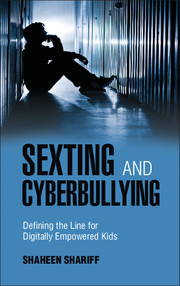Book contents
- Frontmatter
- Dedication
- Contents
- Preface
- Acknowledgments
- Chapter One Confronting Cyberbullying
- Chapter Two Sexism Defines the Lines between Fun and Power
- Chapter Three The Irony of Charging Children with Distribution of Child Pornography
- Chapter Four Keeping Kids Out of Court: Jokes, Defamation, and Duty to Protect
- Chapter Five From Lord of the Flies to Harry Potter: Freedom, Choices, and Guilt
- Appendix A Charting Out Canadian and U.S. Anti-Bullying Legislation (as it Applies or Can be Applied to Cyberbullying Incidents)
- Appendix B Expanded DTL Research Data
- Appendix C Sample Workshop Provided to Undergraduate Students at McGill University
- Appendix D Public Policy, Law, and Digital Media (Sample University-Level Course)
- Index
Appendix D - Public Policy, Law, and Digital Media (Sample University-Level Course)
Published online by Cambridge University Press: 18 December 2014
- Frontmatter
- Dedication
- Contents
- Preface
- Acknowledgments
- Chapter One Confronting Cyberbullying
- Chapter Two Sexism Defines the Lines between Fun and Power
- Chapter Three The Irony of Charging Children with Distribution of Child Pornography
- Chapter Four Keeping Kids Out of Court: Jokes, Defamation, and Duty to Protect
- Chapter Five From Lord of the Flies to Harry Potter: Freedom, Choices, and Guilt
- Appendix A Charting Out Canadian and U.S. Anti-Bullying Legislation (as it Applies or Can be Applied to Cyberbullying Incidents)
- Appendix B Expanded DTL Research Data
- Appendix C Sample Workshop Provided to Undergraduate Students at McGill University
- Appendix D Public Policy, Law, and Digital Media (Sample University-Level Course)
- Index
Summary
Course Summary
This course is for undergraduate students in the Faculty of Law, but may also be of interest to Master of Law students who are interested in public policy as it relates to new technologies. It is also valuable for graduate education students (school principals, senior teachers).
Context, Rationale, and Objectives
The goal of this course is to provide law students with an understanding of contemporary public policy challenges that have emerged with the rapid evolution of technologies and extensive adoption of digital forms of communication. Legal boundaries that were traditionally taken for granted have become increasingly blurred as policy makers in government, public institutions, and the corporate world attempt to balance free expression, privacy, protection, accountability, culpability, and regulation of online content. Students will consider questions about whether existing legal frameworks can adequately address and inform public policy, or whether public policy debates on uses of the Internet and digital media will inevitably re-shape the law.
Why is a course on public policy and technology important for law students? There is currently much debate in the news media and academic and public forums on how we might better manage, control, monitor, regulate, and legislate online communication, particularly as it relates to social media and smart phones. Of particular concern in these policy debates are cases involving online hate, cyber-threats; cyberbullying; sexting; child pornography; trolling; identity theft; online extortion; and similar offenses. An alarming number of teen suicides resulting from cyberbullying and online rape culture have brought urgency to public policy agendas that call for increased and focused legislative action at both the federal and provincial levels.
- Type
- Chapter
- Information
- Sexting and CyberbullyingDefining the Line for Digitally Empowered Kids, pp. 201 - 211Publisher: Cambridge University PressPrint publication year: 2014

